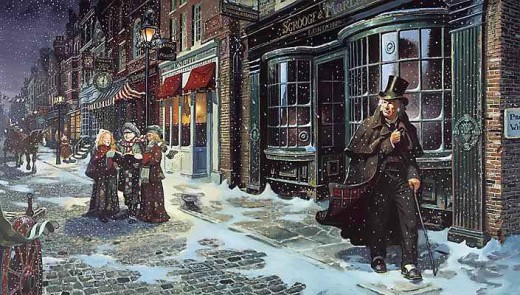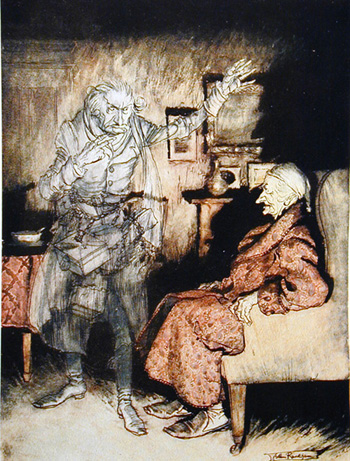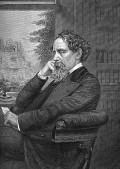Ebenezer Scrooge - Thank You, Charles Dickens, for the Christmas Carol!

When he invented Ebenezer Scrooge, Charles Dickens became a Hollywood script writer before Hollywood even existed!
I'm not sure when I began to consider reading A Christmas Carol each year a part of my Christmas traditions. However, since I came to that conclusion, I've also added several great versions of the Christmas Carol movies to my yearly must-see list, and have enjoyed them thoroughly every year.
One year, I spent a couple of days before Christmas using the fireplace for heat and a lantern and candles for light. There was a thick layer of ice over the snow outside, and power lines were down all over town. Unlike most of my neighbors, I didn't mind it. I liked the idea that we were all forced to stop the bustle just a few days before we were celebrating a major holiday. We were outside of our own time, because our computers were useless, and we couldn't watch TV or play movies or video games. Most of us were also staying home and not braving the black ice on the roads.
I decided that was the perfect time to find a comfy chair, snuggle under a lap quilt and read A Christmas Carol. After dark, I read in front of the fireplace, in the silence of pre-electric times. I was very content, with my cup of hot cider and this exquisite book. That evening, I felt almost as if I was reading what Charles Dickens had just published. Not that I had a nineteenth century mindset, but that, in reading this book by candle and firelight, I was reading it by the same light, and in the same quiet, that it was originally read by. Since then, I have preferred to drink hot cider and have the fireplace lit when I'm reading A Christmas Carol.
Charles Dickens wrote A Christmas Carol in 1843. The story is both an optimistic view of humanity and a scathing portrayal of Victorian society. Dickens had already written Oliver Twist and Nicholas Nickleby, and his determination to reform a shallow, materialistic Victorian society was spreading among his readers. Before writing A Christmas Carol, he had visited the tin mines and had seen the miners, along with their children, working and living under appalling conditions, at the mercy of rich, selfish and parsimonious men. He lived in London at a time when people from the country were being pushed into the cities, and conditions were nothing short of horrible. The average lifespan of a low income Londoner was 27, and half of all deaths were children under the age of 10. He saw the conditions they lived under personally because he took long walks through the streets of London on a regular basis.
Dickens also knew the dangers of not having money, and the fear of being poor. His father had fallen deeply in debt at one point during Dickens' childhood. While his father had languished in debtor's prison, he'd been forced to work ten-hour days gluing labels on pots of blacking. He knew better than most men in his circles what being poor meant for the average working family and what they might be subjected to if they didn't have a decent employer.
When he wrote A Christmas Carol, he wrote his sentences to serve multiple purposes. The resulting novella is an exciting classic, and, even though it concerns terrible conditions for working people, it's not preachy or heavy-handed. It's full of description and action and humor. While it contains concepts that were powerful then, and have remained powerful today, they are a part of the natural fabric of the story.
Best of all, it's a great story! A miserable, rich and parsimonious old man is taken on a life-changing journey by three ghosts, the ghosts of Christmas past, present and future. He has the opportunity to take this journey only because his dead partner, who was the same kind of man as Scrooge, has intervened to rescue him. His partner's ghost is frustrated, because he had the power to help people when he was alive, and ignored them; now that he's dead, all he has is time to notice them, and he can no longer do anything for them - he is a powerless shade.
However, old Scrooge doesn't want to be visited by any ghost, even his old partner, and he doesn't feel the need to be rescued. Nevertheless, the ghosts take him on fantastical rides, one by one, and expose his life to him. They also show him the love that others around him have for each other as they celebrate Christmas together. Then they scare him witless by showing him his future. And the ending is worth the whole show.
A Christmas Carol has been printed and reprinted for over 160 years. It's been played on the stage, made into movies, and adapted to several other media. People can't resist it, and they're always ready to do variations on it. I love to watch the different movies about Scrooge, to see which scenes have been changed, or even left out, and to see who plays what character and how each character acts.
A few times, the story has even been made into a musical. Actually, one of those musicals is one of my favorite versions of A Christmas Carol. Albert Finney plays Scrooge and the title of the musical is - well, "Scrooge". It's very well done. I enjoy the songs, because they fit into the plot and dialogue the way too many musicals only wish their songs did. The music is lively and the lyrics are very clever. The special effects are also fantastic and the scene settings are very realistic. The story zips along at a good pace. And last -but really first -, Albert Finney as Scrooge is nothing short of amazing!

My favorite of the older Scrooges is another movie titled "Scrooge" with Alistair Sim. Actually, it was the first movie titled "Scrooge", and was made in 1951. Alistair Sim is such a wonderfully bad guy, scared and grouchy at the same time, and later completely transformed.
Another great old movie version is Reginald Owen as Scrooge. He was an excellent British actor (all of my favorite Scrooges are British). In general, as a whole version, I probably like this one the best. It was made in 1938, and gritty old London really does look gritty.
George C. Scott (1984) and Patrick Stewart (1999) have also each done a good job as Scrooge. If I liked George C. Scott, I might even list that movie version as one of my top three.
The "Scrooged" (1988) movie, starring Bill Murray, is hilarious. It has great dialogue and sight gags, as well as lively and interesting characters. If you want a version of Scrooge that's guaranteed to keep a diverse group of people entertained, this one is a good choice.
There is also a Muppet version, and I've seen it, but not all the way through. I watched the recent Disney Christmas Carol computer animated version with voices by Jim Carrey and Gary Oldman. I thought the animation was great, but I was disappointed that so much plot was lost to action scenes. I wouldn't let young children see the Disney animated version; it has some parts that might be too scary for young children. One of my top three versions would be more fitting for young children. I know they're more fitting for me.









